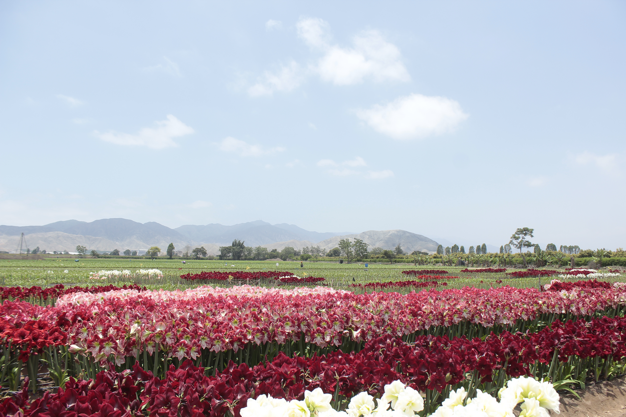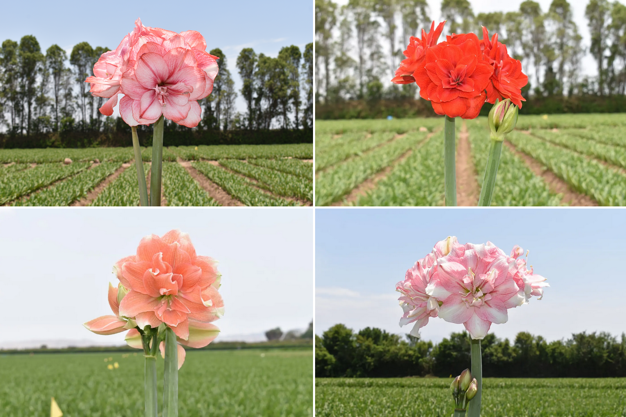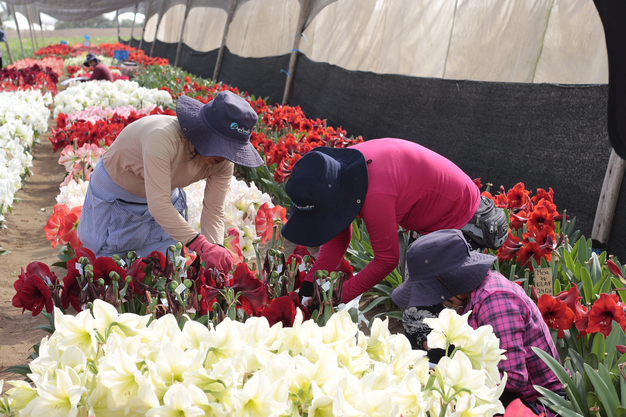In the coastal desert valley of the Andean foothills, AgroFloral Perú S.A.C. produces amaryllis bulbs. Their assortment includes red, white and pink bulbs, as well as bicolor and double color varieties. The bulbs are exported to fifteen different countries. We interviewed the company's Sales and Business Development Manager, Salvador Donoso Ruiz-Tagle, to learn more about the company, this year's season, and the latest market trends.

Past and present
Today, AgroFloral Perú S.A.C. produces its amaryllis bulbs in Canete, Peru. This has not always been the case. In 1999, the Peruvian-Chilean company started bulb production in Chile. Yet, in 2008, they moved to Peru for the country's climatic and soil conditions. Salvador points out that the company's product range and activities developed over the years, saying: "Initially, we grew only eight different bulb varieties that were exported to a single Dutch grower. Today, we offer more than sixty different genotypes, which are exported to fifteen different countries. Since 2004 we entered into the realm of breeding. One of our earliest breeding successes was the Red Victory. More recently, we launched the Tika series (double varieties), and the Andes series (single varieties)."

An impression of the Tika series. Clockwise: Tika Fairy, Tika Imperator, Tika Disco, and Tika Coral.
Currently, the company is in the midst of the harvesting process. And so far, business went well this season, Salvador states. "This year's season has been quite positive for us. Until now, everything went smoothly and according to plan. Even the weather conditions were better than expected. The temperatures have been regulated, which has resulted in less stress on the crops, and better overall results. Thanks to good relationships with strategic partners, also the logistics went well. However, it's still too early to definitely label this season as successful. Nevertheless, based on current progress, we believe it will turn out to be a good one."

Double varieties, a broader range of colors, and wax flowers
According to Salvador, the demand for amaryllis did not change considerably. What has changed, he says, are the consumer preferences. "This season, the demand has been good, it was similar to that of previous years. We have noticed some shifts in the distribution of these demands. Overall, though, the demand remains positive. Yet, we see trends that indicate that customers want us to offer a wide range of varieties."
When asked to explain this further, he says the following: "Classic colors like red and white continue to dominate the market, particularly during the Christmas season. At this moment we work with several varieties, but for the red varieties the main ones are Sovereign and Red Victory. The Red Victory, has been particularly well-received in the market. For white varieties, we use Denver and White Candle, with the latter showing great potential due to the size of its flower.
Despite the dominance of these colors, I observed that customers are increasingly demanding double varieties, and catalogs with a wide range of colors and variations. Interestingly, younger generations are showing more interest in double varieties and a broader range of colors. So, I believe this trend is partly due to the entry of other generations into the flower-buying market, as well as the fact that customers are more informed and no longer content with classic varieties. I think it also has to do with the way consumption happens nowadays, there's always a search for something new or different."
Salvador noticed another trend in the amaryllis market, namely, the "significant" development and growth in the demand for wax flowers. He comments: "Our bulbs have proven to be suitable for this type of format. We are developing our own brand, which will allow us to differentiate ourselves, and offer a product that stands out for its quality. To meet this demand and to prepare for future changes in demand, we aim to introduce new varieties each year with our breeding program. With the Andes Amaryllis brand, we are creating new designs for wax flowers, focusing on quality and design."
Dealing with the El Niño phenomenon
Aside from keeping an eye on changing demand, Salvador is confronted with the El Niño phenomenon, which poses challenges for bulb cultivation. Yet, he tells that he managed to deal with these challenges.
"Maintaining our quality amidst a changing climate scenario has been one of the main challenges that we have faced. Environmental conditions vary from year to year and become increasingly extreme. For example, last year during the El Niño phenomenon, we had to intensify all our controls and efforts throughout the cultivation process to ensure the quality of our products. However, we have overcome these challenges by implementing new technologies, adaptive agricultural practices, and strategic collaborations to anticipate and adapt more effectively to sudden climate changes. This season we already experienced the effectiveness of the implemented measures."

Aiming for further growth
Yet, Salvador highlights that further development and innovation are crucial to exploit present and future business opportunities. "We believe that the primary opportunity for our company lies in our commitment to quality. Aside from that, we are always looking for new and interesting markets where we can bring our bulbs. However, we have a rather conservative and planned growth strategy for opening new markets. We aim to grow while maintaining quality, so we always plan the entry into a new market with all areas of the company.

We see our breeding program as a significant opportunity for innovation and growth. Constantly developing new varieties through our breeding efforts allows us to stay ahead of market trends, and offer products that meet the evolving needs of our customers. We believe that this will set us apart, and strengthens our market position. Although we cannot predict the future, we always strive to be ready for it," he concludes.
For more information:
AgroFloral Perú S.A.C
www.afperu.com










